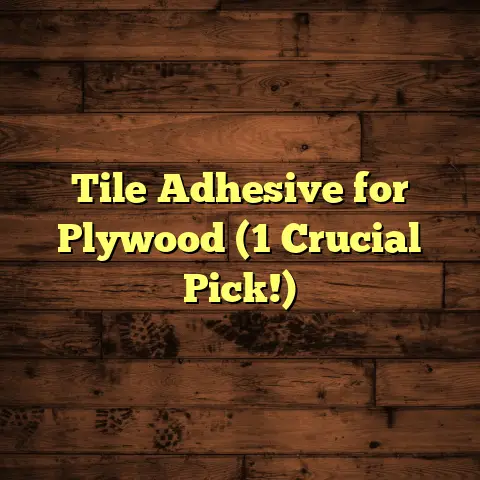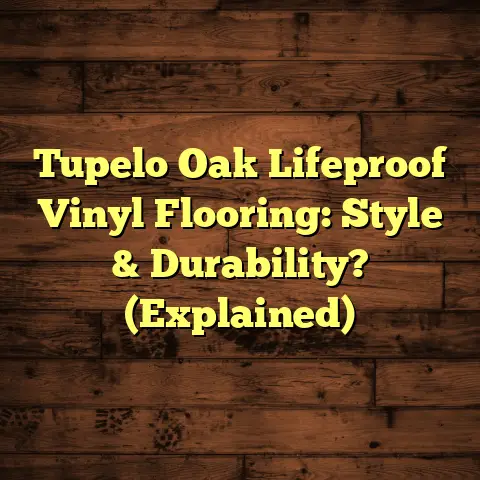Fiber Cement As Flooring? (2 Substrate Traps!)
I’m talking about smart homes – the kind that practically run themselves.
We’re not just talking about fancy lights you can control with your phone.
It’s about integrating everything: security, climate, entertainment, and even how our floors perform.
Think about it: a smart home is all about convenience, efficiency, and being eco-friendly.
We want materials that last, are easy to clean, and look great with our minimalist, tech-savvy vibes.
That’s where flooring comes in. It’s gotta be durable, low-maintenance, and look the part.
And lately, I’ve been seeing more and more buzz around fiber cement as a potential flooring solution.
I mean, fiber cement? Really?
It’s usually siding, right?
Well, stick with me.
We’re going to dive into whether this stuff is a smart choice for your smart home, or if it’s just a trendy idea with some hidden pitfalls.
I’ve been in the flooring business for over 15 years, and I’ve seen trends come and go.
Some are great, some are… well, let’s just say they end up being a pain in the neck.
So, is fiber cement flooring a winner?
Let’s find out together, shall we?
We’ll look at what it is, what makes it tick, and, most importantly, what you need to watch out for.
Trust me, there are a couple of substrate traps you absolutely need to know about before you even think about installing this stuff.
Ready? Let’s get started!
Section 1: Understanding Fiber Cement
1.1 What is Fiber Cement?
Okay, so what is fiber cement, anyway?
Basically, it’s a composite material.
Think of it like a super-strong recipe made from cement, cellulose fibers (that’s basically wood pulp), sand, and a few other additives to give it extra oomph.
The magic happens in the manufacturing process.
They mix all these ingredients together, then press them into sheets of various thicknesses and sizes.
These sheets are then cured, sometimes with steam, to harden them and make them incredibly durable.
The result? A material that’s tough, resistant to all sorts of nasties, and surprisingly versatile.
It doesn’t rot, bugs don’t like it, and it won’t catch fire easily.
That’s why you see it used so often for siding on houses.
But the question is, does that translate to good flooring?
We’ll get there, I promise.
1.2 Historical Context and Evolution
Fiber cement isn’t exactly new on the block.
It’s been around for over a century.
It was originally developed as an alternative to asbestos cement, which, as you probably know, turned out to be a health hazard.
So, fiber cement was born out of a need for a safer, more durable building material.
Over the years, the manufacturing process has improved a lot.
The materials used have become more refined, and the finishes have gotten way more sophisticated.
Back in the day, it was pretty basic stuff.
Now, you can get fiber cement that looks like wood, stone, or just about anything else you can imagine.
This versatility is one reason why it’s starting to pop up in more unexpected places, like flooring.
It’s come a long way from being just a utilitarian siding material.
1.3 Advantages of Fiber Cement Flooring
Alright, let’s talk about the good stuff.
What are the actual benefits of using fiber cement as flooring?
Well, for starters, it’s incredibly durable.
This stuff can take a beating.
Think high-traffic areas, kids running around, pets doing their thing – fiber cement can handle it.
It’s also moisture-resistant, which is a huge plus.
Unlike wood, it won’t warp or rot if it gets wet.
This makes it a good option for bathrooms, kitchens, and even basements where moisture can be a problem.
And did I mention it’s insect-resistant?
Termites and other creepy crawlies won’t be munching on your floors.
Plus, it’s fire-resistant.
This can give you some extra peace of mind.
Another big advantage is low maintenance.
You don’t need to seal it or refinish it regularly like you do with wood.
A simple sweep and mop usually does the trick.
Finally, it’s suitable for both indoor and outdoor applications.
Think about a seamless transition from your living room to your patio.
Pretty cool, right?
But before you get too excited, let’s talk about those substrate traps.
Because even with all these benefits, there are some potential headaches you need to be aware of.
Section 2: The Two Substrate Traps of Fiber Cement Flooring
Okay, here’s where things get real.
Fiber cement flooring can be a great option, but it’s not foolproof.
There are two major substrate traps that can turn your dream floor into a nightmare if you’re not careful.
I’ve seen it happen, and trust me, it’s not pretty.
2.1 Substrate Trap #1: Moisture Issues
2.1.1 Understanding Moisture and Its Impact
Moisture is the enemy of pretty much any flooring material.
Too much moisture can cause wood to warp and rot, tile to crack, and vinyl to peel.
And fiber cement, despite being moisture-resistant, isn’t immune to moisture-related problems.
Think about it: your home is constantly exposed to moisture, from humidity in the air to spills on the floor.
Even if you live in a dry climate, you can still have moisture issues underneath your flooring, especially if your subfloor isn’t properly sealed.
2.1.2 Identifying the Risks with Fiber Cement
So, what are the specific risks with fiber cement flooring and moisture?
Well, even though it’s moisture-resistant, it’s not completely waterproof.
If moisture gets trapped underneath the fiber cement, it can cause problems.
The fiber cement itself might not rot, but the subfloor underneath it could.
This can lead to swelling, warping, and even mold growth.
And that’s not something you want to deal with.
Another risk is that the moisture can affect the adhesives used to install the fiber cement.
This can cause the flooring to loosen and become unstable.
I’ve seen cases where entire sections of fiber cement flooring had to be ripped up because of moisture problems.
It’s a costly and time-consuming mess.
2.1.3 Mitigation Strategies
Alright, so how do you avoid these moisture-related disasters?
The key is to be proactive and take steps to prevent moisture from becoming a problem in the first place.
Here’s what I recommend:
-
Proper Subfloor Preparation: This is absolutely crucial. Make sure your subfloor is clean, level, and dry before you even think about installing fiber cement. If it’s concrete, test it for moisture levels. There are moisture meters you can buy or rent that will tell you if the concrete is too damp. If it’s wood, make sure it’s properly sealed and free of any rot or decay.
-
Moisture Barriers: Install a moisture barrier underneath the fiber cement. This will help prevent moisture from rising up from the subfloor and affecting the flooring. There are different types of moisture barriers available, so talk to your flooring supplier about what’s best for your situation. Polyethylene sheeting is a common and affordable option.
-
Ventilation: Make sure your home is properly ventilated. This will help reduce humidity levels and prevent moisture from building up. Use exhaust fans in bathrooms and kitchens, and consider investing in a dehumidifier if you live in a humid climate.
-
Proper Installation: Follow the manufacturer’s instructions carefully when installing the fiber cement. Use the right adhesives and sealants, and make sure everything is properly aligned and secured. Don’t cut corners!
-
Regular Inspections: Keep an eye on your flooring and look for any signs of moisture problems, such as discoloration, swelling, or mold growth. If you spot anything suspicious, address it immediately.
By taking these steps, you can significantly reduce the risk of moisture-related problems with your fiber cement flooring.
2.2 Substrate Trap #2: Incompatibility with Other Flooring Materials
2.2.1 Understanding Compatibility Issues
Okay, let’s talk about another potential pitfall: incompatibility with other flooring materials.
Fiber cement isn’t a standalone product.
It needs to be installed over a subfloor, and that subfloor can be made of different materials like wood, concrete, or even vinyl.
The problem is, fiber cement doesn’t always play nicely with these other materials.
Different materials expand and contract at different rates when exposed to changes in temperature and humidity.
This can cause stress on the flooring system and lead to problems like cracking, movement, and uneven wear.
2.2.2 The Consequences of Incompatibility
So, what happens when you install fiber cement over an incompatible substrate?
Well, here are a few potential scenarios:
-
Cracking: If the substrate expands or contracts at a different rate than the fiber cement, it can cause the flooring to crack. This is especially common with concrete subfloors that aren’t properly cured or sealed.
-
Movement: The fiber cement can shift and move if it’s not properly bonded to the substrate. This can create gaps between the flooring and the walls, and it can also make the flooring feel unstable underfoot.
-
Uneven Wear: If the substrate is uneven, it can cause the fiber cement to wear unevenly. This can lead to premature failure of the flooring.
-
Adhesive Failure: The adhesive used to install the fiber cement can fail if it’s not compatible with the substrate. This can cause the flooring to loosen and come apart.
I’ve seen all of these problems firsthand, and they’re not fun to deal with.
That’s why it’s so important to choose the right substrate and installation methods.
2.2.3 Installation Best Practices
So, how do you ensure compatibility during the installation of fiber cement flooring?
Here are a few best practices:
-
Choose the Right Substrate: If possible, choose a substrate that’s known to be compatible with fiber cement. Concrete is generally a good option, as long as it’s properly cured and sealed. Wood can also work, but it needs to be properly prepared and sealed to prevent moisture problems.
-
Use an Appropriate Underlayment: An underlayment can help to create a buffer between the fiber cement and the substrate. This can help to reduce stress and prevent cracking. There are different types of underlayment available, so talk to your flooring supplier about what’s best for your situation.
-
Proper Joint Treatments: Pay close attention to the joints between the fiber cement panels. Use the right joint fillers and sealants to prevent moisture from penetrating and causing problems.
-
Acclimation: Allow the fiber cement panels to acclimate to the room’s temperature and humidity for several days before installation. This will help to minimize expansion and contraction after installation.
-
Consult a Professional: If you’re not sure about any aspect of the installation, consult a professional flooring contractor. They can assess your specific situation and recommend the best materials and methods for your project.
By following these best practices, you can minimize the risk of compatibility problems and ensure a successful fiber cement flooring installation.
Section 3: Comparative Analysis
3.1 Fiber Cement vs. Traditional Flooring Options
Let’s face it: fiber cement is still a bit of an unconventional choice for flooring.
So, how does it stack up against more traditional options like hardwood, laminate, and tile?
Here’s a quick comparison:
| Feature | Fiber Cement | Hardwood | Laminate | Tile |
|---|---|---|---|---|
| Cost | Moderate | High | Moderate | Moderate to High |
| Durability | Excellent | Good (requires care) | Moderate | Excellent |
| Maintenance | Low | Moderate to High | Low | Low |
| Moisture Resistance | Excellent | Poor | Moderate | Excellent |
| Aesthetic Appeal | Varies (can mimic others) | High | Varies (can mimic wood) | High |
| Installation | Moderate (requires skill) | Moderate to High | Moderate | Moderate to High |
As you can see, fiber cement has some advantages over traditional flooring options, particularly in terms of durability and moisture resistance.
However, it may not be as aesthetically appealing as hardwood or tile, and it can be more challenging to install than laminate.
Ultimately, the best flooring option for you will depend on your specific needs and preferences.
3.2 Fiber Cement in the Smart Home Context
So, how does fiber cement fit into the smart home picture?
Well, it actually aligns pretty well with some of the key principles of smart home design.
For example, smart homes are often focused on sustainability and energy efficiency.
Fiber cement is a relatively sustainable material, as it’s made from recycled materials and doesn’t require the harvesting of trees.
It can also help to improve energy efficiency by providing insulation.
Smart homes are also all about ease of maintenance.
Fiber cement is a low-maintenance material that doesn’t require sealing or refinishing.
This can save you time and money in the long run.
And finally, smart homes are often designed with durability in mind.
Fiber cement is an incredibly durable material that can withstand heavy use and resist damage from moisture, insects, and fire.
So, in many ways, fiber cement is a natural fit for the smart home.
Conclusion: The Future of Fiber Cement in Flooring
So, what’s the verdict?
Is fiber cement flooring a smart choice for your home?
Well, it depends.
If you’re looking for a durable, low-maintenance, and moisture-resistant flooring option, fiber cement is definitely worth considering.
However, it’s important to be aware of the potential substrate traps and take steps to mitigate them.
Proper subfloor preparation, moisture barriers, and compatible installation methods are essential for a successful fiber cement flooring installation.
Looking ahead, I think we’ll see more innovation in flooring materials, particularly in the context of smart homes.
We’ll see new materials that are even more durable, sustainable, and easy to maintain.
And who knows, maybe fiber cement will become a mainstream flooring option in the future.
Only time will tell.
But for now, if you’re considering fiber cement flooring, do your research, talk to a professional, and be sure to avoid those substrate traps!
References and Further Reading
- Fiber Cement Siding Association: https://www.fibercement.org/
- “Moisture Control Handbook: Principles and Practices for Residential Buildings” by Joseph Lstiburek
- “Sustainable Building Materials Sourcebook” by Alison G. Kwok and Walter T. Grondzik
- ASTM International: (Search for standards related to fiber cement testing and installation) https://www.astm.org/




